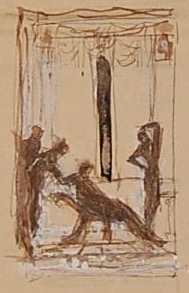The only surviving moving images of Charles Ricketts show him quickly closing his mouth when he laughed to prevent the viewer from seeing his bad teeth. It is precisely with such a scene that the story of Joséphine de Beauharnais and Napoleon begins in Unrecorded Histories. Joséphine, after eating some sweets (intended for her guests), uses a different trick:
Madame de Beauharnais smiled often and well, it was one of her many attractions, but she smiled with a graceful downward movement of the head to conceal this blemish.
The story, called 'The Sword', is set in the circular boudoir in Joséphine's house in around 1795, just before Napoleon would propose marriage to her (in Unrecorded Histories, her name is consistently spelled without an acute accent). Ricketts describes her hairstyle and dress and the room in which she and her daughter wait for visitors. The furniture belongs to the reign of Louis XVI,
[...] it had been given a touch of fashion by the addition of jonquil-coloured curtains and a long swan-headed couch, on which Madame de Beauharnais reclined toying with the sweets on a gilded tripod by her side.
 |
| Charles Ricketts, 'The Sword' |
Ricketts's illustration shows the swan-headed bench, but the tripod is out of view. The curtains are suggested by semi-circles that hang down from the ceiling.
In several stories in this posthumous collection, Ricketts openly introduces homosexual characters (whereas he used to be very secretive about sex). In this story, one of the guests enters with 'a youth of extraordinary beauty', who 'passed as his nephew, some said his son, others his latest favourite'.
His beige-coloured tights and myrtle-green coat moulded every line of his body, and from his prim-rose coloured waistcoat hung a collection of chains, watches and seals. Yes, Achilles was beautiful, thought Josephine, who adored beauty [...]
After greeting the hostess, Achilles 'leant languidly against a mirror, where he looked like Narcissus tired of his own reflection. [The book contains the spelling error ‘liked’ instead of ‘like.’]
In the illustration, Achilles is the figure on the right. The two figures on the left are a rich manufacturer, Lucien Tillleux, who kisses her hand, and 'a rich profiteer', Népomucène Théoleyre, who holds 'a dwarf myrtle plant in a Sèvres pot'. A striking difference between the sketch and the illustration is the raised hand holding the flower pot, which does not appear in the sketch.
The conversation about the uncertain political situation – in which France seemed to be developing a need for a sword – reminds the hostess of her uncertain times after the Revolution, when she was imprisoned and her first husband was guillotined. This goes completely over Achilles' head, who acts like 'all beautiful young animals', and seems to have become infatuated with Joséphine's daughter. Meanwhile, one of the other visitors, Théoleyre, is fascinated by Achilles' beauty, which makes his patron La Chèze uneasy.
 |
| Charles Ricketts, sketch for Unrecorded Histories [Collection British Museum: 1946,0209.122] [Creative Commons Attribution-NonCommercial-ShareAlike 4.0 International (CC BY-NC-SA 4.0) license] [© With permission of the executors of the Charles Ricketts estate, Leonie Sturge-Moore and the heirs of Charmain O'Neil] |